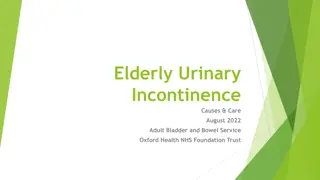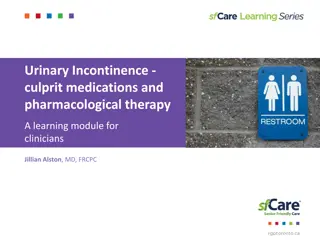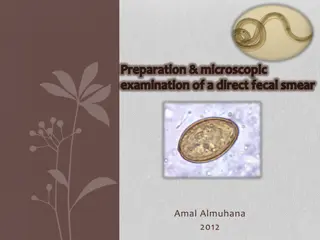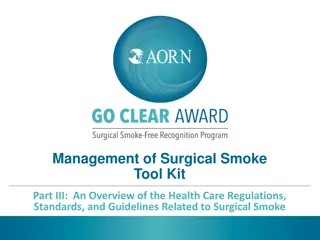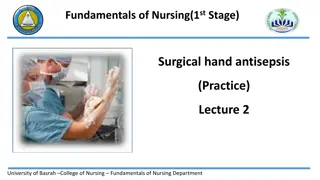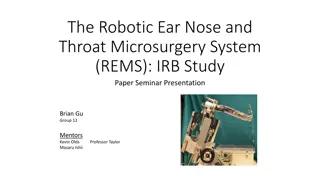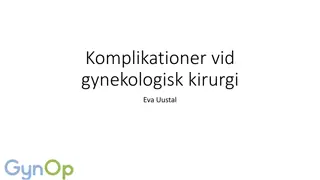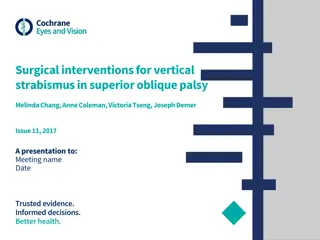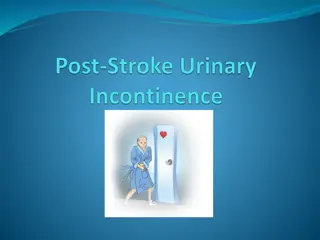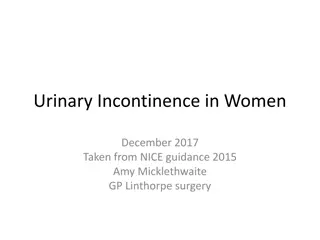Fecal Incontinence New Surgical Options
Fecal incontinence leads to the recurrent inability to control bowel movements. Trauma, surgical procedures, obstetric complications, and various medical conditions can contribute to this issue. Evaluation includes an assessment of medical history, stool frequency, and digital exams, with additional testing such as endoanal ultrasound and anal manometry. Scoring systems like the Cleveland Clinic Incontinence Score and Fecal Incontinence Quality of Life help measure the impact on daily living. Surgical options can be considered for management.
Download Presentation

Please find below an Image/Link to download the presentation.
The content on the website is provided AS IS for your information and personal use only. It may not be sold, licensed, or shared on other websites without obtaining consent from the author.If you encounter any issues during the download, it is possible that the publisher has removed the file from their server.
You are allowed to download the files provided on this website for personal or commercial use, subject to the condition that they are used lawfully. All files are the property of their respective owners.
The content on the website is provided AS IS for your information and personal use only. It may not be sold, licensed, or shared on other websites without obtaining consent from the author.
E N D
Presentation Transcript
Fecal Incontinence Fecal Incontinence New Surgical Options New Surgical Options Duc M. Vo, MD Northwest Surgical Specialists
Disclosures none
Outline Definition Etiologies Exam findings Additional testing Medical management Surgical options
What is fecal incontinence? Recurrent inability to voluntarily control the passage of bowel contents through the anal canal Partial Incontinence smearing, soiling, uncontrolled flatus Complete Incontinence passage of feces without the patient's knowledge, or without voluntary contraction, or both
Etiology Trauma Surgical (e.g., fistulectomy, fistulotomy, hemorrhoidectomy, sphincterotomy, sphincter stretch, pull-through operations, low anastomoses) Obstetric Accidental (e.g., penetrating or avulsion injury, social injury) Colorectal disease hemorrhoids, rectal prolapse, inflammatory bowel disease, malignant tumors, radiation Congenital anomaly spina bifida, myelomeningocele, imperforate anus, Hirschsprung's disease Neurologic disease Cerebral (e.g., tumor, vascular accident, dementia, trauma) Spinal Peripheral (e.g., diabetes mellitus, multiple sclerosis, pudendal nerve injury) Miscellaneous conditions Laxative abuse, Diarrheal conditions, Fecal impaction, Encopresis Corman, M. Colon and Rectal Surgery 5th ed
Scoring Systems Cleveland Clinic Incontinence Score Incontinence to flatus, liquid or solid stool, wearing a pad, lifestyle alterations 0 (perfect continence)- 20 (complete incontinence) Fecal Incontinence Quality of Life (FIQL) 29 items considers lifestyle alterations, coping behavior, depression/self-perception, and embarrassment
Epidemiology prevalence of 0.4 18% 3:1 female/male Nelson et al, JAMA 1995
Evaluation Trauma, obstetric hx, anorectal surgery Stool frequency, consistency Colon cancer screening Perianal exam Digital exam Anoscopy Proctoscopy
Additional Testing Endoanal ultrasound Anal manometry Electromyography Pudenal nerve terminal motor latency Defecography
Medical Management Bowel management program maintaining optimal fecal consistency, stimulating peristalsis, and controlling the time of evacuation Fiber (25-30 grams/day) Stool softeners, constipating medications, laxative, or even stimulant cathartics Pelvic floor physical therapy-biofeedback
Surgical Options Sphincteroplasty Solesta Sacral Nerve Stimulation
Sphincteroplasty Fang et al, DCR 1984
Results after Sphincteroplasty 70-80 % success 60% acceptable to excellent 5 year outcomes 50% at 10 years Gutierrez et al, DCR 2004 Oom et al, DCR 2009
Solesta FDA approved in 2011 biocompatible bulking agent in an injectable gel dextranomer microspheres in stabilized hyaluronic acid 4 injections in the submucosal layer of the anal canal
Solesta Results Randomized sham controlled trial 206 pts (2:1) 52% noted improvement in symptoms (>50% improvement) at 6 and 12months Compared to 31% in sham group Graff et al, Lancet 2011
Sacral Nerve Stimulation Implantable system sends electrical pulses near the 3rd sacral nerve to modulate the neural activity Influences the behavior of the pelvic floor, lower urinary track, urinary and anal sphincters, and colon. FDA approve in 2011
Interstim 3-7 days test phase Partial implant Full implant
Sacral Nerve Stimulation Results Systematic review 41-75% complete fecal continence, 75-100% improvement of episodes of incontinence 5 year follow up of 67 patients, > 50% improvement in 89%, and 36% complete continence, 35% required revision, replacement, or explant. Jarrett et al, Br J Surg 2004 Tull et al, DCR 2013
Algorithm Treat associated conditions Sphincter Injury- sphincteroplasty Conservative management Bowel regimen, biofeedback Mildly patulous anus- Solesta Poor sphincter function- Sacral Nerve Stimulator
Conclusion Awareness of the prevalence of fecal incontinence Screening is important Fecal incontinence is treatable
For more information contact Duc M. Vo, MD Northwest Surgical Specialists 3355 Riverbend Dr. Suite 300 Springfield, OR 97477 541-868-9303 www.nwsurgicalspecialists.com





